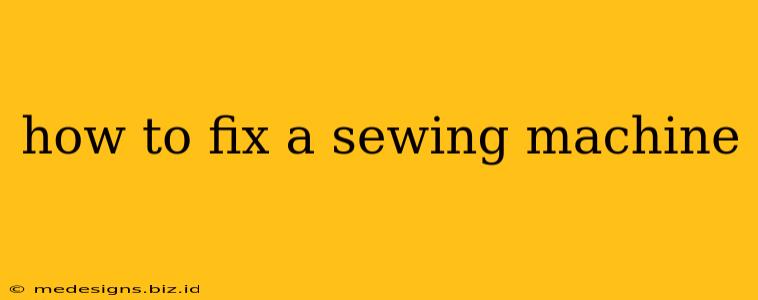So, your trusty sewing machine has decided to take a break? Don't panic! Many common sewing machine problems can be solved with a little know-how and some basic troubleshooting. This comprehensive guide will walk you through common issues, their causes, and how to fix them, empowering you to get back to stitching in no time.
Identifying the Problem: The First Step to Repair
Before you dive into repairs, accurately identifying the problem is crucial. Ask yourself these questions:
- What is the machine doing (or not doing)? Is it making strange noises? Is it skipping stitches? Is it refusing to sew at all? Be specific in your description.
- When did the problem start? Did it happen suddenly, or gradually worsen? Knowing the timeline can help pinpoint the cause.
- What were you sewing when the problem occurred? Were you using a thick fabric? A new needle? The type of fabric and materials used can impact machine performance.
Common Sewing Machine Problems and Solutions
Let's tackle some of the most frequently encountered sewing machine issues:
1. The Sewing Machine Won't Turn On:
- Cause: Check the power cord, wall outlet, and circuit breaker. Ensure the power switch on the machine itself is engaged.
- Solution: Try a different outlet. Check the fuse or circuit breaker. Inspect the power cord for any damage.
2. Skipped Stitches:
- Cause: This is a common problem with several potential causes: a bent or dull needle, incorrect tension settings, improper threading, or a clogged bobbin case.
- Solution:
- Replace the needle: Always use a new needle appropriate for the fabric type. A bent or dull needle is a major culprit.
- Check the tension: Adjust the upper and lower tension dials. Consult your machine's manual for the correct settings.
- Inspect the threading: Ensure the thread is correctly threaded through all the guides and the take-up lever.
- Clean the bobbin case: Remove the bobbin case and clean out any lint or debris.
3. Broken Needle:
- Cause: Sewing through thick fabric without the right needle, hitting a pin or other hard object, or using a bent needle.
- Solution: Replace the broken needle with a new one of the correct size and type for your fabric.
4. Jammed Machine:
- Cause: Fabric or thread tangled in the machine's internal mechanisms.
- Solution: Carefully remove any tangled fabric or thread. Consult your machine's manual for instructions on accessing and cleaning the internal parts. Never force anything.
5. Inconsistent Stitches:
- Cause: Uneven thread tension, dirty feed dogs, or worn-out parts.
- Solution: Adjust the tension settings. Clean the feed dogs with a brush. If the problem persists, it may require professional servicing.
Maintenance is Key: Preventing Future Problems
Regular maintenance is crucial for keeping your sewing machine running smoothly. Here are some essential maintenance tips:
- Clean regularly: Remove lint and dust from the bobbin case, feed dogs, and other areas. Use a soft brush or compressed air.
- Oil periodically: Use sewing machine oil specifically designed for your machine model. Refer to your manual for oiling points and frequency.
- Replace parts as needed: Worn needles, bobbins, and other parts should be replaced promptly.
- Store properly: Keep your machine covered when not in use to prevent dust accumulation.
When to Call a Professional
While many sewing machine problems can be solved at home, some issues require the expertise of a professional repair technician. If you've tried the troubleshooting steps above and the problem persists, it's best to consult a professional. Ignoring significant problems can lead to more extensive and costly repairs.
By following these tips and regularly maintaining your sewing machine, you can ensure many years of reliable stitching. Happy sewing!
